Ba9.9
The B text was probably designed to begin 4 days before Rigel
- the star at the left Foot of Orion above the head of the Hare - had
become visible close to the Full Moon in
December 7.
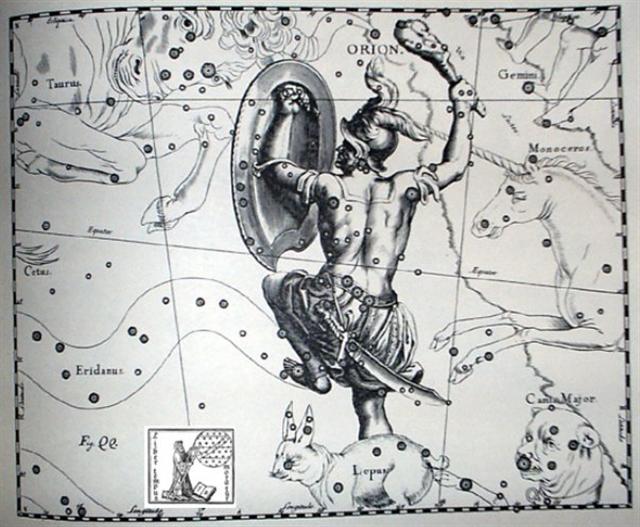
Perhaps this date had been conceived from (10 *
7) / 365.25 * 26000 = AD 1842 + 3140 BC, considering the Mayan view
that Itzam-Yeh (Ursa Major) had been defeated 9 years
earlier in 3149 BC.

However, a less complicated explanation would be to regard 10-7 as an allusion to 107 (→
16 * 29½ - 365), i.e. as a measure for the difference between the
length of the Moon cycle and that of the Sun cycle.
|
NO GLYPH |
 |
 |
 |
 |
 |
|
Ba1-1 |
Ba1-2 |
Ba1-3 |
Ba1-4 |
Ba1-5 |
|
Ka
tuu
i te Ragi |
ki te henua e rua - no
Hoatumatua - ka hakanohoa |
|
 |
2 |
 |
|
Beid
(The Egg) |
AIN
(The Eye) |
|
|
VISIBLE CLOSE
TO THE FULL MOON: |
|
MARCH 31
(455) |
APRIL 1 (91) |
2 |
3 |
4 (459 = 94 + 365) |
5 (460) |
|
ALMAAZ = ε Aurigae
(74.7),
HAEDUS I = ζ Aurigae
(74.8) |
Han-shih-tsieh (Eating
of Cold Food) |
ĸ Leporis (78.0),
RIGEL (Foot) =
β
Orionis
(78.1),
Flaming Star = IC405
(78.2),
CAPELLA =
α
Aurigae (78.4),
ο
Columbae,
τ
Orionis (78.8)
*37.0 = *78.4 - *41.4
THUBAN (α Draconis) |
λ Aurigae (79.0), λ Leporis (79.6), ρ Aurigae
(79.7)
ARCTURUS (α Bootis) |
|
HAEDUS II = η Aurigae
(75.9) |
5h (*76.1)
ε
Leporis (76.0),
CURSA (Footstool) = β Eridani (76.4),
λ Eridani (76.7)
*35.0 = *76.4 - *41.4
|
μ Aurigae, μ Leporis (77.6) |
|
... In view of the almost universal prevalence
of the Pleiades year throughout the Polynesian
area it is surprising to find that in the South
Island and certain parts of the North Island of
New Zealand and in the neighboring Chatham
Islands, the year began with the new Moon after
the yearly morning rising, not of the Pleiades,
but of the star Rigel in Orion ... |
|
June 3 (154) |
4 (91 + 64) |
5 (156) |
6 (314 / 2) |
7 |
8 (524) |
 |
|
To find the corresponding position
of the Sun we should add *183 right
ascension days, because according to
the Era of Bharani (*41.4)
the star Cursa (*76.4 - *41.4 =
*35.0 = "April 25) was precisely
*185 right ascension days earlier
than ο Ophiuchi; *220.0 - *35.0 =
*185.0. |
|
HAEDUS II |
Cursa |
*2
|
Capella |
*183
|
ο Ophiuchi |
|
*76.4 |
*78.4 |
*261.4 |
|
June 4 (155) |
5
(156 = 80 + 76) |
June 7 (158 = 80 + 78) |
June 8 (524 = 460 + 64) |
|
APRIL 1 (91) |
2
(156 - 64 = 92) |
APRIL 4 (158 - 64
= 94) |
APRIL 5 (95 + 365 = 460) |
|
"April 24 (114) |
25 (156 - 41 =
115 = *35.0) |
"April 27 (158 - 41 = 117 = *37) |
"Oct 27 (524 - 41 = 483 = 300 +
183) |
|
186 (= 1 + 261.4 - 76.4) |
|
|
INVISIBLY
CLOSE TO THE SUN: |
|
SEPT 30 (272
+ 1) |
OCT 1 |
2 (275) |
3 |
4 (341 - 64 = 277) |
5 |
|
κ Ophiuchi (256.2), ζ Arae (256.5), ε Arae
(256.8),
CUJAM (Club) = ε Herculi
(256.9) |
No star listed (257) |
17h (*258.7)
ARRAKIS = μ Draconis
(258.7) |
Mula-19 (The Root)
SABIK (The Preceding One) =
η
Ophiuchi
(259.7),
η
Scorpii (259.9) |
NODUS I =
ζ
Draconis
(260.0),
π
Herculis (260.7),
RAS ALGETHI =
α
Herculis
(260.8) |
SARIN =
δ
Herculis
(261.0),
ο
Ophiuchi (261.4)
*220.0 = *261.4 - *41.4
ALRISHA (α Piscium) |
|
Dec 3 (336 +
1) |
4 |
5 |
6 (157 + 183) |
7 (341) |
8 (9 * 29 +
80) |
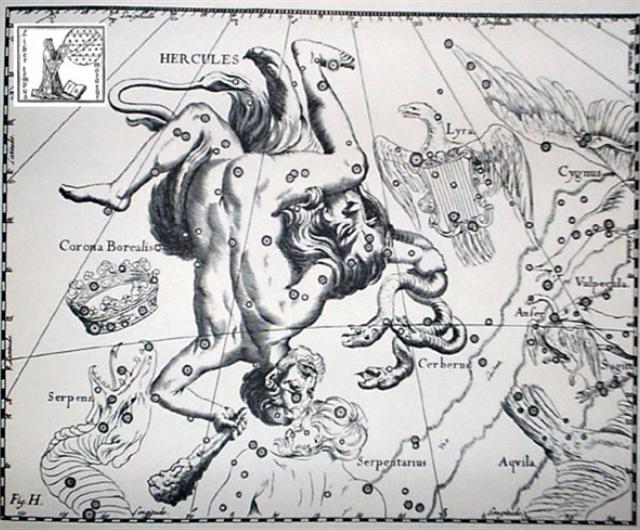 |
And then another view of the year seems to have been presented 348 (= 12
* 29 = *365 + *56 - *73) days (glyph positions) later in
the text, where
Alcyone in the Pleiades would have been rising together with the Sun.
...
in the South Island and certain parts of the
North Island of New Zealand and in the neighboring
Chatham Islands, the year began with the new Moon after
the yearly morning rising, not of the Pleiades, but of
the star Rigel in Orion
...
On side b of the C tablet there are 348 glyphs, which we
can
compare with 365 + 56 (Alcyone) = 421
= 348 + 73 (→ 365 /
5) number of glyphs on side a of the B
tablet.
... As soon as one has mastered the
elementary grammar and accidence of myth, and built up a
small vocabulary, and learned to distinguish seasonal
myths from historical and iconotropic myths, one is
surprised how close to the surface lie the explanations,
lost since pre-Homeric times, of legends that are still
religiously conserved as part of our European cultural
inheritance. For example, the various legends of the
halcyon, or kingfisher which like the wren, is
associated in Greek myth with the winter solstice. There
were fourteen 'halcyon days' in every year, seven of
which fell before the winter solstice, seven after,
peaceful days when the sea was smooth as a pond and the
hen-halcyon built a floating nest and hatched out her
young. According to Plutarch and Aelian, she had another
habit, of carrying her dead mate on her back over the
sea and mourning him with a peculiarly plaintive cry.
The number fourteen is a moon-number,
the days of the lucky first half of the month; so the
legend (which has no foundation in natural history,
because the halcyon does not build a nest at all but
lays its eggs in holes by the waterside) evidently
refers to the birth of the new sacred king, at the
winter solstice - after his mother, the Moon-goddess,
has conveyed the old king's corpse to a sepulchral
island. Naturally, the winter
solstice does not always coincide with the same phase of
the moon, so 'every year' must be understood as 'every
Great Year', at the close of which solar and lunar time
were roughly syncronized and the sacred king's term
ended ...
Pliny, who carefully describes the
halcyon's alleged nest - apparently the zoöphyte called
halcyoneum by Linnaeus - reports that the halcyon
is rarely seen and then only at the winter and summer
solstices and at the setting of the Pleiades. This
proves her to have originally been a manifestation of
the Moon-goddess who was worshipped at the two solstices
as the Goddess of alternatively Life-in-Death and
Death-in-Life - and who early in November, when the
Pleiades set, sent the sacred king his summons to death
...
 |
 |
 |
 |
 |
 |
 |
|
Ba9-1 |
Ba9-2 |
(7 *
7 * 7) |
Ba9-4 (344) |
Ba9-5 |
Ba9-6 |
Ba9-7 |
|
ki te ahi |
kua rere ki te ragi |
kua hati ïa i to toa
- i rapue |
ko te tagata kua haga |
ki te mea ke |
kua hakatega koia |
ki mua o te tagata -
hua ia |
|
Hati 1. To break (v.t., v.i.);
figuratively: he hati te pou oka,
to die, of a hopu manu in the
exercise of his office (en route from
Motu Nui to Orongo). 2.
Closing word of certain songs. Vanaga.
Hahati. 1. To break (see hati).
2. Roughly treated, broken (from
physical exertion: ku hahati á te
hakari) 3. To take to the sea: he
hahati te vaka. Vanaga. Ha(ha)ti.
To strike, to break, to peel off bark;
slip, cutting, breaking, flow, wave (aati,
ati, hahati); tai hati,
breakers, surf; tumu hatihati,
weak in the legs; hakahati, to
persuade; hatipu, slate. P Pau.:
fati, to break. Mgv.: ati,
hati, to break, to smash. Mq.:
fati, hati, id. Ta.: fati,
to rupture, to break, to conquer.
Churchill.
Rapu. Pau.:
fata-rarapu, to dissolve. Mgv.:
rapu, to dilute. Ta.: rapu,
to mix. Mq.: ápu, to draw water.
Churchill. Ha.: Lapu 1. Ghost ...
apparition, phantom, specter; haunted;
to haunt; to act as a ghost. Ua
lapu ke
keiki a kāua ia'u, I have been
haunted by our child.
Ho'o lapu,
to pretend to be a ghost, as children on
Hallowe'en. 2. Haunted. Hale
lapu,
haunted house, not the Halloween
variety. Kiliki o
lapu,
trick or treat. Wehewehe. Waving (of
leafy branches). The Eighth Island.
Aga. Work; to
work, to make, to build, to create: O
te atua i-aga-ai i te ragi, i te henua.
God made heaven and earth. Vanaga.
Agahuru (hagahuru,
hagauru). Agai (hagai).
Agatahi (aga-tahi) one, (hagatahi);
agatahi ahi atu, day before
yesterday; hagatahi ahi,
yesterday. Churchill. Ao popohaga,
the hours between midnight and dawn.
Vanaga.
Haga. 1. Bay,
fishing spot. (Figuratively) he haga
o te ákuáku, it is the [evil]
spirit's fishing spot, i.e. a place
where they hide waiting for people to
fall under their power. 2. To want, to
love. Ku haga á i te vai, I want
water, I am thirsty. Vanaga. 1. Bay,
strait, anchorage, strand, beach. P Mq.:
hana, haka, small bay,
creek, cove. 2. Work, labor, employment,
act, affair, creation, design, state,
maker, fashion, manufacture, occupation,
profession; to do, to make, to
construct, to employ, to form, to
manufacture, to fashion, to found, to be
busy with; haga rakerake, crime;
tagata haga ei mea, mercenary;
haga no iti, to plot mischief;
haga ke, to act contrary; haga
takataka, to disjoin; haga nui,
difficulty, fatigue, to weary; tuhi
ki te haga, to give employment;
haga hakahou, to make over, to
renew, recovery; haga koroiti, to
deal prudently; haga nuinui ke,
to overburden. P Pau.: haga, to
do, action, work, a deed. Mgv.: haga,
aga, work, labor. Mq.: hana,
haka, action, act, work,
occupation. Ta.: haa, work, to
labor, to make. 3. Agreement, conduct,
liking, intention, desire, will; to
resolve, to permit, to endeavor, to
tolerate, to be willing, to wish, to
approve; haga ihoiho, fixed
desire; haga mai, haga no mai,
to agree, to hearken favorably; tae
haga, despite, involuntary, to
refuse, to renounce; noho hakahaga,
apathy. 4. = haka. Pau.: haga
= haka. 5. Mgv.: haga, a
fish. Mq.: haka, id. 6. Mgv.:
haga, a fishtrap. Sa.: faga,
a fish-trap, bird-cage. Ma.: hanganoa,
a small basket for cooked fish. 7. Mgv.:
haga, a measure of a fathom. Ta.:
aa, to measure length. Mq.:
aka, ana, to measure with the
arms. Ma.: whanga, id. Churchill.
Hagaava (haga 1 - ava
2), entrance of a harbor. Hagahaga:
1. (haga 2), work. 2. hesitation,
to hesitate. Churchill.
Hagahuru. Ten (agahuru,
hagauru). P Mq.: onohuú,
okohuú, id. Ta.: ahuru.
id. Churchill. The Maori recognized two
main divisions of the year: winter or
takurua, a name for Sirius which
then shone as morning star, and summer,
raumati or o-rongo-nui,
'of the great Rongo', god of
agriculture. They occasionally
recognized spring as the digging season
koanga, from ko, the
digging stick or spade. The autumn or
harvest season was usually spoken of as
ngahuru, 'tenth' (month),
although it was considered to include
also the last two months of the year.
Mahuru was the personification of
spring. Makemson.
The five stages
of a baby's development are: kaukau,
puepe, tahuri, totoro, mahaga.
Puepue = said of a newborn baby
when, a few weeks old, it begins to
distinguish people and objects:
ku-puepue-á te poki. Tahuri =
of a new-born baby, to move from side to
side: ku-tahuri-á te poki.
Totoro = to crawl; ki totoro te
poki, when the baby crawls.
Mahaga = baby when able to stand by
itself. Vanaga.
Hua. 1. Testicle.
2. Figuratively: son, hua tahi,
only son; fruits of the earth; to grow
well (of fruits). 3. To cause a fight, a
quarrel. Hua-ai, generation, as
lineage of direct descendents;
contemporaries. Huahua, coccyx of
bird, 'parson's nose': huahua
moa, huahua uha. Huataru,
a creeper (Chenopodium
ambiguum). Vanaga. 1. The same;
ki hua, again, to continue, to
strain, to struggle, to move, to repeat,
over and above. Mq.: hua, the
same, to return, to recommence. 2. To
bloom, to sprout; flower, fruit (huaa);
huaa tae oko, huaa vahio,
young fruit; hua atahi, only son;
huahaga, fruit; mei te huahaga
o tokoe kopu, the fruit of thy body;
tikea huahaga, deceptive
appearance. P Pau.: ua, to be
born; huahaga, lineage. Mgv.:
hua, to produce (said of trees,
grain, etc.), blooming time of flowers,
abundance of fruit. Mq.: hua, to
produce, to bear fruit. Ta.: ua,
to sprout. Huahua. 1. Tailless
fowl. 2. Vein, tendon, line. 3. Mgv.:
huahua, pimples covering the face.
Ta.: huahua, id. Mq.: hua,
tubercules. Sa.: fuafua, abscess
on hand or feet. Ma.: huahua,
small pimples. Pau.: Hua-gakau,
rupture. Ta.: áau, entrails. Sa.:
ga'au, id. Ma.: ngakau,
id. Churchill. 1. Fruit. 2. Egg. 3. Tā
hua = 'genealogical writing' or
'same writing'. Fischer.
Mate. 1. To die;
he-mamate te gagata, many people
die. 2. To faint, to lose consciousness;
he-tutu ka mate ró to beat
someone senseless (often used
hyperbole). 3. To feel an overwhelming
desire, to be dying for; he mate ki
te vai, to be dying for a drink of
water. 4. Manava mate,
infatuated, in love (with something). 5.
To be overwhelmed with pain: mate-á i
te mamae. Matega, death.
Vanaga. Death, to die, to be ill, to be
unfortunate. Hakamate, to kill. P
Pau.: mate, to die. Mgv.: mate,
to be sick, dead, love, ardent desire.
Mq.: mate, illness, death, grief.
Ta.: mate, death, illness.
Matea, lifeless, passionate.
Matega, death. Mgv.: matega,
illness, death. Matekeo (mate
- keo) pulmonary disease.
Matemanava (mate - manava)
to marvel at. Matemate, to have a
slight illness, to suffer pain.
Materaa (mate - raa)
sunstroke. Matevai (mate -
vai) thirst. Churchill.
... in the ceremonial
course of the coming year, the king is
symbolically transposed toward the
Lono pole of Hawaiian divinity ...
It need only be noticed that the renewal
of kingship at the climax of the
Makahiki coincides with the rebirth
of nature. For in the ideal ritual
calendar, the kali'i battle
follows the autumnal appearance of the
Pleiades, by thirty-three days - thus
precisely, in the late eighteenth
century, 21 December, the winter
solstice. The king returns to power with
the sun. Whereas, over the next two
days, Lono plays the part of the
sacrifice. The Makahiki effigy is
dismantled and hidden away in a rite
watched over by the king's 'living god',
Kahoali'i or
'The-Companion-of-the-King', the one who
is also known as 'Death-is-Near' (Koke-na-make).
Close kinsman of the king as his
ceremonial double, Kahoali'i
swallows the eye of the victim in
ceremonies of human sacrifice ... |
|
VISIBLE CLOSE TO THE FULL MOON: |
|
SEPT
5 |
6 |
7
(250) |
(342
- 91) |
9 |
(80 +
237 - 64) |
(345 - 91) |
|
ο
Cor. Borealis (232.0),
δ
Lupi (232.1),
φ¹,
ν²
Lupi (232.2),
ν¹
Lupi (232.3),
ε
Lupi (232.4),
φ²
Lupi (232.5),
PHERKAD (The Dim One of the Two Calves)
=
γ
Ursae Min.
(232.6),
ε
Librae (232.7),
η
Cor. Borealis (232.8),
υ
Lupi (232.9)
*191.0 = *232.4 - 41.4 |
ALKALUROPS (The Herdsman's Lance) =
μ
Bootis
(233.1),
ED ASICH (Male Hyena) =
ι
Draconis
(233.2)
|
NUSAKAN (Pauper's Bowl) = β Cor. Bor.
(234.0), κ¹ Apodis (234.3), ν Bootis
(234.7), ζ Librae (234.9)
|
θ Cor. Borealis (235.3), γ Lupi (235.6),
GEMMA = α Cor. Bor.,
ZUBEN ELAKRAB = γ Librae, QIN = δ
Serpentis, ε Tr. Austr.
(235.7), μ Cor. Borealis (235.8), υ
Librae (235.9)
SIRRAH (α Andromedae) |
φ Bootis (236.2), ω Lupi, τ Librae
(236.3), ψ¹ Lupi (236.7),
ζ Cor. Borealis
(236.9) |
κ
Librae (237.2),
ι
Serpentis (237.4),
ψ²
Lupi,
ρ
Oct.
(237.5), γ Cor. Borealis, η Librae
(237.7), COR
SERPENTIS = α Serpentis
(237.9)
*196.0 = *237.4 - *41.4 |
π
Cor. Borealis,
UNUK ELHAIA (Necks of the Serpents) =
λ
Serpentis
(238.1),
CHOW =
β
Serpentis
(238.6) |
|
...
In other words, the ancient Druidic
religion based on the oak-cult will be
swept away by Christianity and the door
- the god Llyr - will languish forgotten
in the Castle of Arianrhod, the
Corona Borealis [below the upside
down right foot of Hercules]. This helps us to
understand the relationship at Rome of
Janus and the White Goddess Cardea who
is ... the Goddess of Hinges who came to
Rome from Alba Longa. She was the hinge
on which the year swung - the ancient
Latin, not the Etruscan year - and her
importance as such is recorded in the
Latin adjective cardinalis - as
we say in English 'of cardinal
importance - which was also applied to
the four main winds; for winds were
considered as under the sole direction
of the Great Goddess until Classical
times ... |
|
INVISIBLY CLOSE TO THE SUN: |
|
ALGENIB PERSEI = α Persei (50.0),
ο Tauri (50.2), ξ Tauri (50.8)
GIENAH (γ Corvi) |
σ Persei (51.6) |
No star listed (52) |
ψ
Persei (53.1)
ACRUX (α
CRUCIS) |
δ Persei
(54.7) |
Al Thurayya-27
(Many Little Ones) /
Krittikā-3 (Nurses
of Kārttikeya) /
TAU-ONO (Six
Stones)
ATIKS =
ο
Persei, RANA (Frog) =
δ
Eridani
(55.1),
CELAENO (16 Tauri), ELECTRA (17),
TAYGETA (19),
ν
Persei (55.3), MAIA (20), ASTEROPE (21),
MEROPE (23)
(55.6) |
Hairy Head-18
(Cockerel) /
Temennu-3
(Foundation Stone)
ALCYONE
(56.1),
PLEIONE (28 Tauri), ATLAS (27 Tauri)
(56.3) |
|
May
10 (130) |
(80 + 51) |
(250
- 118) |
13
(133) |
(252
- 182 + 64) |
(365
+ 135) |
16
(136) |
|
"March 30 |
31 |
"April 1 (91) |
2 |
3 |
4 |
5 (136 - 41) |
 |
70 |
 |
110 |
 |
|
Ba9-5 (345) |
Ca5-20 (125) |
Ba9-5 (135 ← 527 → 364) |
|
ki
te mea ke |
hakapekaga
mai |
ki
te mea ke |
|
δ Persei
(54.7) |
Bright
Fire (125.4)
*125.4 - *41.4 = *84.0 |
ζ Cor. Borealis (236.9) |
|
May 14 (134 = *419) |
July 24 (205 = *490) |
Nov 12 (316 = *236 = *601 -
*365) |
|
"April 3 (93, *13 = *378) |
"June 13 (164, *84 = *449) |
"Oct 2 (275 = *195 = *560 -
*365) |
|
MARCH 11
(70, *355) |
MAY 21 (141, *61 = *426) |
SEPT 9 (252, *172 = *537 -
*365) |
|
183 |
|
Then a bird with only one wing (kara etahi) was looking back in
MARCH 14 (3-14),
... needfire ceremonies
usually take place near the summer solstice (the
Feast of St. John) ... but they occur in several
other seasons as well. The summer date of the
rite and its accompanying festival have to do,
among other things, with fertility, as can can
clearly be seen in a variant from the valley of
the Moselle preserved for us by Jakob Grimm.
Each household in the village was constrained to
contribute a shock of straw to the nearby high
place, Stromberg, where the males went at
evening while the females went to a spring lower
down on the slope. A huge wheel was wrapped with
this straw. An axle run through the wheel served
as the handles for those who were to guide it on
its downward plunge. The mayor of a nearby town
kindled the straw, for which office he was
rewarded with a basketful of cherries. All the
men kindled torches and some followed the
burning orb as it was released downhill to
shouts of joy. The women at the spring echoed
these shouts as the wheel rushed by them. Often
the fire went out of its own accord before it
reached the river, but should the waters of the
river extinguish it, an abundant vintage was
forecast for that year ...
and a further 6 days later ahead was
3-20, alluding to
Dramasa (*320.0 at the South
Pole):
 |
 |
 |
 |
 |
 |
 |
|
Ba9-8 (354 - 6) |
Ba9-9 |
Ba9-10 (350) |
Ba9-11 |
Ba9-12 |
Ba9-13 → 273 |
(273 + 81) |
|
e tara tuu |
o to vaha - o
te marama - ko te marama |
kua haga ia i
te ika |
e kua rere ko
te manu |
ki te huaaga |
o to kava -
kua huri ko to hatu |
kua tupu ko to
toa |
|
Tara.
1. Thorn: tara miro.
2. Spur: tara moa. 3. Corner;
te tara o te hare, corner of
house; tara o te ahu, corner
of ahu. Vanaga. (1. Dollar;
moni tara, id.) 2. Thorn,
spike, horn; taratara,
prickly, rough, full of rocks. P
Pau.: taratara, a ray, a
beam; tare, a spine, a thorn.
Mgv.: tara, spine, thorn,
horn, crest, fishbone. Mq.: taá,
spine, needle, thorn, sharp point,
dart, harpoon; taa, the
corner of a house, angle. Ta.:
tara, spine, horn, spur, the
corner of a house, angle. Sa.:
tala, the round end of a house.
Ma.: tara, the side wall of a
house. 3. To announce, to proclaim,
to promulgate, to call, to slander;
tatara, to make a genealogy.
P Pau.: fakatara, to enjoin.
Mq.: taá, to cry, to call. 4.
Mgv.: tara, a species of
banana. Mq.: taa, a plant, a
bird. Ma.: tara, a bird. 5.
Ta.: tara, enchantment. Ma.:
tara, an incantation. 6. Ta.:
tara, to untie. Sa.: tala,
id. Ha.: kala, id. Churchill.
Kava. 1.
Sour; salty: vai kava,
saltwater, sea; te kava o te
haíga, acrid underarm smell;
tagata kava - tagata kakara i te
kava, man with smelly armpits.
2. He-kava te haha, to be
thirsty. 3. To turn sour, to become
embittered, bad-tempered,
exasperated (used with manava):
tagata manava kava,
bad-tempered, angry man. Vanaga.
Bitter, salt; vai kava,
brackish water; hakakava, to
embalm; kavakava, acid,
sharp, bitter, salt, spiritous,
vinegar, poisonous, disagreeable;
akavakava, to make sharp;
hakakavakava, to make acid. P
Pau.: kava, disagreeable to
the taste; kavakava, acid,
sharp. Mgv.: kava, to be
bitter, sour, acid, salt. Mq.:
kava, bitter. Ta.: ava,
bitter, acid, salt. Kavahia:
1. Comfort, comfortable, to feast;
hakakavahia, comfort,
comfortable. 2. Repulsive (of food),
disgusted; hakakavahia,
repulsion. Kavakava, rib;
moi kavakava, a house god G. P
Mgv.: vakavaka, the breast.
Mq.: vakavaka, vaávaá,
rib. Ma.: wakawaka, parallel
ridges. We shall need all the
available material in order to
determine the germ sense of this
word. Sa.: va'ava'a, the
breast-bone of a bird; fa'ava'a,
the frame as of a slate. To.:
vakavaka, the side. Fu.:
vakavaka, the side below the
armpit. Ha.: hoowaa, to make
furrows. In all these we may see the
idea of ridge or depression, or of
both, as primal (Rapanui, Samoa,
Marquesas, Maori, Hawaii), and as
secondary the part of the body where
such appearances is common
(Mangareva, Tonga, Futuna).
Churchill. Mgv.: kava, the
pepper plant and the drink made
therefrom. Ta.: ava, id. Mq.:
kava, id. Sa.: 'ava,
id. Ma.: kawa, a pepper.
Kavakava, a fish. Sa.:
'ava'ava, id. Kavapui, a
tree. Ta.: avapuhi, a
fragrant plant. Mq.: kavapui,
wild ginger. Sa.: 'avapui,
id. Ha.: awapuhi, id.
Churchill. Mq.: ava, a small
fish of sweet water. Sa.. 'ava'ava,
a small fish. Ha.: awa, a
fish. Kakava, burnt. Sa.: 'a'ava,
very hot. Churchill. |
|
INVISIBLY CLOSE TO THE SUN: |
|
MENKHIB (Next to the Pleiades =
ζ
Persei
(57.6)
PORRIMA (γ Virginis) |
ZAURAK (Boat) = γ Eridani
(58.9) |
λ Tauri (59.3), ν Tauri (59.9) |
4h (60.9)
JĪSHUĬ = λ Persei
(60.7)
COR CAROLI (α Canum Ven.) |
υ Persei (61.2) |
BEID (Egg) =
ο¹
Eridani
(62.2),
μ
Persei (62.8)
VINDEMIATRIX ( ε Virginis) |
Al Dabarān-2
(The Follower)
HYADUM I =
γ
Tauri (63.4)
*22.0 = *63.4 - *41.4 |
|
May 17 |
18 |
19 |
20 |
21 |
22 (142) |
23 |
|
"April 6 |
7 |
8 |
9 |
10 |
11 (101) |
12 |
|
3-14 |
MARCH 15 |
16 |
17 |
18 |
19 (78) |
3-20 |
|
... Ecclesiastically, the equinox is
reckoned to be on 21 March (even
though the equinox occurs,
astronomically speaking, on 20 March
[*364] in most years) ... |
MARCH 21 was at glyph number 355 (alluding to the day of
the northern winter solstice).
 |
 |
 |
 |
 |
 |
|
Ba9-15 (355) |
Ba9-16 |
Ba9-17 |
Ba9-18 |
Ba9-19 |
Ba9-20 (360) |
|
koia ra ki te nuku |
e kua tupu i te
tauuru |
e tagata ui ra |
ki te huaga |
kua rere ko te manu |
ki to toa ko to toa |
|
Ui.
To ask. Vanaga.
Û'i.
To look, to look at (ki);
e-û'i koe! look out! Vanaga.
Ui.
1. Question, to interrogate, to ask (ue).
Uiui,
to ask questions. 2. To spy, to inspect,
to look at, to perceive;
tagata ui,
visitor. Churchill. |
|
INVISIBLY CLOSE TO THE SUN: |
|
HYADUM II = δ¹ Tauri
(64.2) |
Net-19 (Crow)
AIN (Eye) = ε Tauri,
θ¹
Tauri,
θ²
Tauri (65.7) |
No star listed (66) |
No star listed (67) |
Rohini-4 (The Red
One) /
Pidnu-sha-Shame-4
(Furrow of Heaven)
/
ANA-MURI-2 (Rear
pillar - at the foot of which was the
place for tattooing)
ALDEBARAN = α Tauri
(68.2),
THEEMIN = υ² Eridani
(68.5) |
No star listed (69) |
|
...
There was no water in the village. The
lakes and rivers were dry. Raven and
Crow, two young girls who were having
their first menstrual courses, were told
to go and draw water from the ocean.
Finding the journey too long, Raven
decided just to urinate into her
basket-bucket. She decieved no one and
was severly scolded. Crow returned much
later but with drinking water. As a
punishment, Raven was condemned never to
find water in the summer; only in winter
would she find something to drink. For
that reason the Raven never drinks
during the hot months; she speaks with a
raucous voice because of her dry throat
...
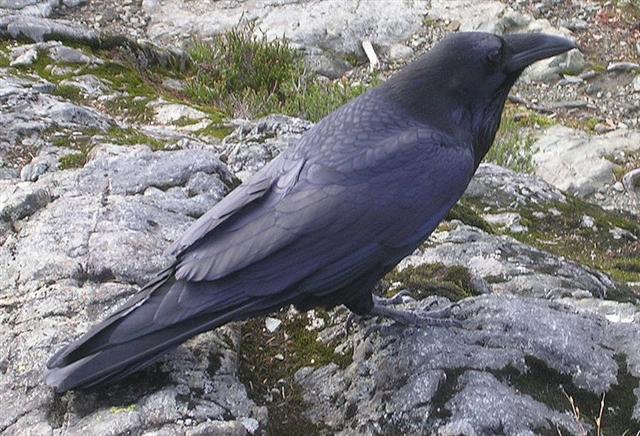 |
|
MARCH
21 (80) |
22 |
23 (=
7 + 16) |
24 |
25 (EQUINOX) |
26 |
|
VISIBLE CLOSE TO THE FULL MOON: |
|
YED POSTERIOR (Hand Behind) =
ε
Ophiuchi,
RUKBALGETHI SHEMALI (Northern Knee of
the Giant) =
τ
Herculis
(246.6).
δ
Apodis (246.7),
ο
Scorpii (246.8) |
Heart-5 (Fox)
σ Scorpii
(247.0),
HEJIAN =
γ
Herculis
(247.2),
ψ
Ophiuchi (247.7) |
ρ
Ophiuchi (248.1),
KAJAM (Club) =
ω
Herculis
(248.3),
χ
Ophiuchi (248.5),
SHE LOW (Market Tower) =
υ
Ophiuchi,
Tr.
Austr. (248.7), ζ Tr. Austr. (248.8) |
Al Kalb-16 (The
Heart) /
Jyeshtha-18
(Eldest) /
ANA-MUA-1
(Entrance pillar)
ANTARES = α Scorpii
(249.1),
MARFIK (Elbow) = λ Ophiuchi,
φ Ophiuchi (249.5), ω Ophiuchi (249.8) |
γ Apodis (250.1), σ Herculis (250.3), θ
Tr. Austr. (250.6), τ Scorpii (250.7) |
HAN = ζ Ophiuchi
(251.0) |

... Proclus informs us that the fox star
nibbles continuously at the thong of the
yoke which holds together heaven and
earth; German folklore adds that when
the fox succeeds, the world will come to
its end. This fox star is no other than
Alcor, the small star g near zeta
Ursae Majoris (in India Arundati,
the common wife of the Seven Rishis,
alpha-eta Ursae ... |
|
Nov
22 (326) |
23 |
24 |
25 |
26 |
27 |
6 days later (at Ba9-27 and MARCH 27) the place among the stars
corresponding to November 28 (332) would
be at the Full Moon.
... The correspondence
between the winter solstice and the kali'i
rite of the Makahiki is arrived at as
follows: ideally, the second ceremony of
'breaking the coconut', when the priests
assemble at the temple to spot the rising of the
Pleiades, coincides with the full moon (Hua
tapu) of the twelfth lunar month (Welehu). In
the latter eighteenth century, the Pleiades
appear at sunset on 18 November. Ten days later
(28 November), the Lono effigy sets off
on its circuit, which lasts twenty-three days,
thus bringing the god back for the climactic
battle with the king on 21 December, the
solstice (= Hawaiian 16 Makali'i). The
correspondence is 'ideal' and only rarely
achieved, since it depends on the coincidence of
the full moon and the crepuscular rising of the
Pleiades ...
This correspondence was 'ideal' (i.e. the
established picture), and a slight adjustment
with 4 days in my normal order could put the Club of Hercules at
28 November. Here (Ba9-17) Metoro said they were
looking (ui) at the sun (Tahitian: ra).
But this ought to be the day when the cycle of
Lono (Rogo) began, and we should therefore rather count
16 days earlier in the text in order to find the true
heliacal date. 328 (November 24) - 182 = 146
(May 26):
|
 |
15 |
 |
|
Ba9-1 |
Ba9-17 |
|
ALGENIB PERSEI = α Persei (50.0) |
CURSA (Footstool) = β Eridani (76.4) |
|
MARCH 7 (66 = 50 + 16) |
May 26 (146 = 82 + 64) |
The circuit of Lono (Rogo) would then begin 10 days (glyphs)
later in the B text, when 'November 28 (332)' was at the Full Moon,
i.e. at Ba9-27. 338 (December 4) - 182 = 156 (June 5).
|
 |
15 |
 |
|
Ba9-11 (351) |
Ba9-27 (367) |
|
4h (60.9) |
SAIPH (Sword) =
κ
Orionis |
|
MARCH 17
(76 = 60 + 16) |
June 5
(156 = 92 + 64) |
|
Egyptian hand |
 |
Phoenician kaph |
 |
Greek
kappa |
Κ (κ) |
|
Kaph is thought
to have been derived from a pictogram of
a hand (in both modern Arabic and modern
Hebrew, kaph means palm/grip) ...
...
The manik, with the tzab,
or serpent's rattles as prefix, runs
across Madrid tz. 22 , the figures in
the pictures all holding the rattle; it
runs across the hunting scenes of Madrid
tz. 61, 62, and finally appears in all
four clauses of tz. 175, the so-called
'baptism' tzolkin. It seems impossible,
with all this, to avoid assigning the
value of grasping or receiving. But in
the final confirmation, we have the
direct evidence of the signs for East
and West. For the East we have the glyph
Ahau-Kin, the Lord Sun, the Lord
of Day; for the West we have
Manik-Kin, exactly corresponding to
the term Chikin, the biting or
eating of the Sun, seizing it in the
mouth.



The pictures (from
Gates) show east, north, west, and
south; respectively (the lower two
glyphs) 'Lord' (Ahau) and
'grasp' (Manik). Manik was
the 7th day sign of the 20 and Ahau
the last ... |
The star of the 'Sword' (κ) was at the other
(right) foot of Orion, 10 days after Cursa (the
Footstool for his left foot).

 |
 |
 |
 |
 |
|
Ba9-21 (19 *
19) |
Ba9-22 |
Ba9-23 |
Ba9-24 (364) |
Ba9-25 |
|
kua haga ki te marama |
kua tupu te toa |
ko te manu - kua haga ia ki
te toa |
te kava ku huri ïa |
ki to hatu |
|
INVISIBLY
CLOSE TO THE SUN: |
|
MARCH 27 |
28 |
29 (88 = 152
- 64) |
30 |
31 |
|
No star listed (70) |
TABIT =
π³
Orionis
(71.7),
π²
Orionis (71.9) |
π4
Orionis (72.1),
ο¹
Orionis (72.4),
π5
Orionis (72.8)
*31.0 = *72.4 - *41.4 |
π¹
Orionis (73.0),
ο²
Orionis (73.4),
HASSALEH =
ι
Aurigae
(73.6),
π6
Orionis (73.9)
*32.0 = *73.4 - *41.4 |
ALMAAZ = ε Aurigae
(74.7),
HAEDUS I = ζ Aurigae
(74.8) |
 |
|
VISIBLE CLOSE
TO THE FULL MOON: |
|
ζ
Herculis,
η
Tr. Austr.
(252.1), η Herculis, β Apodis (252.5) |
ATRIA = α Tr. Austr.
(253.9) |
Tail-6 (Tiger)
WEI (Tail) = ε Scorpii,
η Arae (254.3),
DENEBAKRAB = μ Scorpii
(254.7) |
ι Ophiuchi (255.3),
GRAFIAS = ζ Scorpii (255.4)
*214.0 = *255.4 - *41.4 |
κ Ophiuchi (256.2), ζ Arae (256.5), ε Arae
(256.8),
CUJAM (Club) = ε Herculi
(256.9) |
|
Nov 28 (355 -
23) |
29 (338 - 5) |
30 |
Dec 1 |
2 (336 = 7 *
48) |
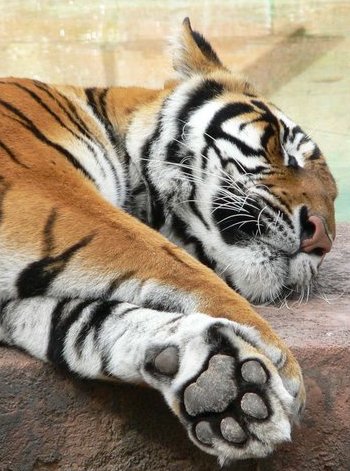 |
It should also be mentioned here that there were *168 right ascension days from Hassaleh in
Auriga to Vrischika in the Scoripon.
 |
 |
*168 |
 |
|
kava |
Ba9-24
(*73) |
Ca9-13
(*241) |
|
HASSALEH |
VRISCHIKA |
|
MARCH 30 (89) |
SEPT 14
(257) |
|
te kava ku huri ïa |
haati kava |

.jpg)
Haedus II (*74) ought to have been visible close to the Full Moon at
Ba1-1. Therefore the same situation ought to return
after 365 glyphs (days). However, I have suggested we
should turn around from Ba9-5 (cfr above) and instead
contemplate the possibility that the B text here instead
could refer to the stars of the rising Sun.
... Nut, whom the Greeks sometimes
identified with Rhea, was goddess of the sky, but it was
debatable if in historical times she was the object of a
genuine cult. She was Geb's twin sister and, it was
said, married him secretly and against the will of Ra.
Angered, Ra had the couple brutally separated by Shu and
afterwards decreed that Nut could not bear a child in
any given month of any year. Thoth, Plutarch tells us,
happily had pity on her. Playing draughts with the Moon,
he won in the course of several games a seventy-second
part of the Moon's light with which he composed five new
days. As these five intercalated days did not belong to
the official Egyptian calendar of three hundred and
sixty days, Nut was thus able to give birth successively
to five children: Osiris, Haroeris (Horus), Set, Isis
and Nepthys ...
Surely the pair of eating persons (tagata kai)
with a dead warrior (toa) hanging down
between them in APRIL 2 could have been intended to illustrate
3 days of cold food, in which case we here ought to read
the text in parallel with the positions of the Sun in the ancient days of the Golden Age of the Bull, when
Thuban had been the star at
the North Pole:
 |
 |
 |
 |
 |
 |
 |
|
Ba9-26
(366) |
Ba9-27 |
Ba9-28 |
Ba9-29 →
108 |
Ba9-30 |
Ba9-31 |
Ba9-32 → 111 |
|
e tagata era e kai |
i te toa e |
tagata kai |
i te vaha - koia ra kua
kai i tona mea |
e kua rave i to haga |
e tagata e |
rave ra |
|
Rave.
Ta.: Rave, to take. Sa.:
lavea, to be removed, of a disease. To.:
lavea, to bite, to take the hook, as a fish.
Fu.: lave, to comprehend, to seize. Niuē:
laveaki,
to convey. Rar.: rave,
to take, to receive. Mgv: rave,
to take, to take hold; raveika,
fisherman. Ma.: rawe,
to take up, to snatch. Ha.: lawe,
to take and carry in the hand. Mq.:
ave, an
expression used when the fishing line is caught
in the stones. Churchill 2. |
|
INVISIBLY
CLOSE TO THE SUN: |
|
APRIL 1 |
2 |
3 |
4 |
5 (95) |
6 |
7 |
|
HAEDUS II = η Aurigae
(75.9) |
5h (*76.1)
ε
Leporis (76.0),
CURSA (Footstool) = β Eridani (76.4),
λ Eridani (76.7)
*35.0 = *76.4 - *41.4 |
μ Aurigae, μ Leporis (77.6) |
ĸ Leporis (78.0),
RIGEL (Foot) =
β
Orionis
(78.1),
Flaming Star = IC405
(78.2),
CAPELLA =
α
Aurigae (78.4),
ο
Columbae,
τ
Orionis (78.8)
*37.0 = *78.4 - *41.4
THUBAN (α Draconis) |
λ Aurigae (79.0), λ Leporis (79.6), ρ
Aurigae (79.7)
ARCTURUS (α Bootis) |
Shur-narkabti-sha-iltanu-5 (Star in the Bull
towards the north)
σ
Aurigae (80.4), BELLATRIX (Female Warrior) =
γ
Orionis, SAIF AL JABBAR (Sword of the Giant)
=
η
Orionis
(80.7),
ELNATH (The Butting One) =
β
Tauri =
γ
Aurigae
(80.9) |
ψ
Orionis (81.1),
NIHAL (Thirst-slaking Camels) =
β
Leporis
(81.7) |
|
Han-shih-tsieh (Eating
of Cold Food) |
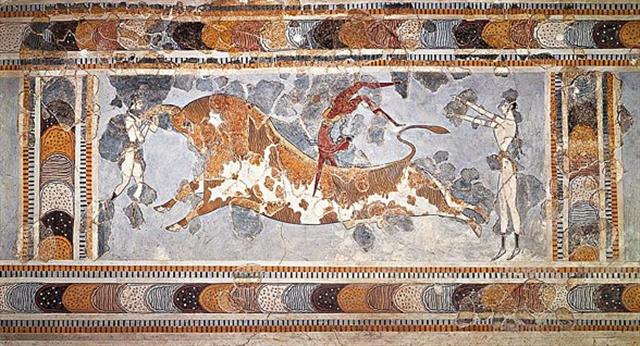 |
|
VISIBLE CLOSE
TO THE FULL MOON: |
|
No star listed (257 = 273 - 16) |
17h (*258.7)
ARRAKIS = μ Draconis
(258.7) |
Mula-19 (The Root)
SABIK (The Preceding One) =
η
Ophiuchi
(259.7),
η
Scorpii (259.9) |
NODUS I =
ζ
Draconis
(260.0),
π
Herculis (260.7),
RAS ALGETHI =
α
Herculis
(260.8) |
SARIN =
δ
Herculis
(261.0),
ο
Ophiuchi (261.4)
*220.0 = *261.4 - *41.4
ALRISHA (α Piscium) |
ξ Ophiuchi (262.2),
θ Ophiuchi, ν Serpentis, ζ, ι Apodis (262.4),
ι Arae (262.8), ρ Herculis (262.9)
*221.0 = *262.4 - *41.4 |
β, γ Arae (263.3), κ Arae (263.5), σ
Ophiuchi (263.6) |
|
Dec 3
(337) |
4 |
5 |
6 |
7 |
8 |
9 (7 * 7
* 7) |
|
"Oct 23
(296) |
24 |
25 |
26 |
27 (300) |
28 |
29 |
|
SEPT 30
(273) |
OCT 1 |
2 |
3 |
4
(277) |
5 |
6 |
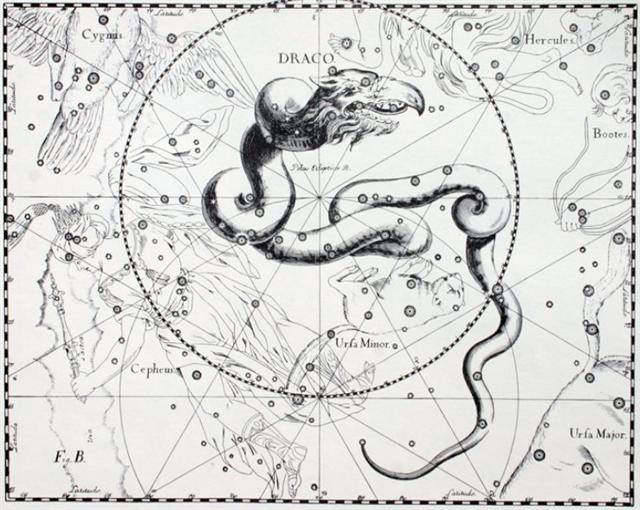 |
One more week is then needed in order to make a
fortnight. Although it was stopped at 10, at the
Pillar of Exit:
 |
 |
 |
 |
 |
 |
 |
|
Ba9-33 |
Ba9-34 |
Ba9-35 (375) |
Ba9-36 |
Ba9-37 |
Ba9-38 |
Ba9-39 |
| ki te
nuku kai |
o to
ua |
to
inoino o to hure |
koia ra - kua haga
ki te mea ke |
e tagata moe ra -
ki mua e |
|
Pahure: 1. To sweep everything away.
2. To wound, to lacerate, scar, bruise, lesion,
sore; pahurehure,
to wound, to scratch;
hakapahure,
to wound. T Pau.:
pahure, to be skinned;
pahore,
to peel off, to scale. Mgv.:
pahore,
to cut off, to chop, to slice. Ta.:
pahore,
to flay, to skin. Churchill 2. |
|
INVISIBLY
CLOSE TO THE SUN: |
|
APRIL 8 |
9 |
10 (465) |
11 |
12 |
13 |
14 (104) |
|
KHUFU
MINTAKA (Belt) =
δ
Orionis,
υ
Orionis (82.4),
χ
Aurigae (82.5),
ε
Columbae (82.6)
*41.0 = *82.4 - *41.4
→
41 Arietis (Bharani) |
KHAFRE
Al
Hak'ah-3 (Brand) /
Mrigashīrsha-5 (Stag's Head) /
Turtle
Head-20 (Monkey) /
Mas-tab-ba-tur-tur (Little Twins)
ARNEB =
α
Leporis, CRAB NEBULA = M1 Tauri
(83.0,
φ¹
Orionis (83.1),
HEKA =
λ
Orionis,
ORION NEBULA = M42
(83.2),
φ²
Orionis (83.6),
ALNILAM (String of Pearls) =
ε
Orionis
(83.7) |
MENKAURE
Three
Stars-21 (Gibbon) /
Shur-narkabti-sha-shūtū-6 (Star in the Bull towards the south) /
ANA-IVA-9 (Pillar of exit)
HEAVENLY GATE =
ζ
Tauri,
ν
Columbae (84.0),
ω
Orionis (84.2),
ALNITAK (Girdle) =
ζ
Orionis,
PHAKT (Phaet) =
α
Columbae
(84.7) |
ο
Aurigae (85.8), γ Leporis (85.9)
YANG MUN (α
Lupi) |
μ
Columbae (86.1), Saiph (86.5),
ζ μ
Columbae,
SAIPH (Sword) =
κ
Orionis
(86.5),
τ
Aurigae,
ζ
Leporis (86.6) |
υ
Aurigae (87.1),
ν
Aurigae (87.2),
WEZN (Weight) =
β
Columbae,
δ
Leporis (87.7),
TZE (Son) =
λ
Columbae
(87.9) |
Ardra-6 (The Moist One) /
ANA-VARU-8 (Pillar to sit by)
χ¹
Orionis,
ξ
Aurigae (88.1),
BETELGEUZE
= α
Orionis
(88.3),
ξ
Columbae (88.5),
σ
Columbae (88.7)
ZUBEN
ELGENUBI (α Librae) |
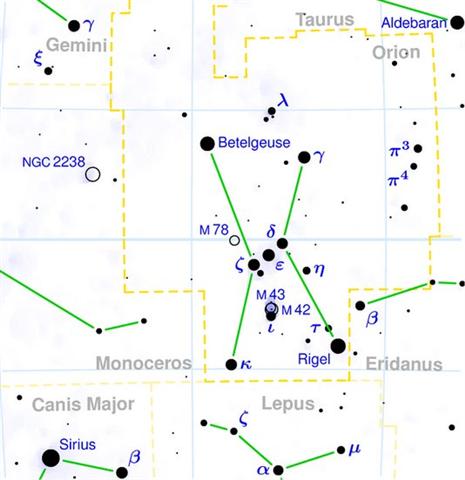 |
|
... Menkaure was allegedly a much more
benevolent Pharaoh than his predecessors.
According to legends related by Herodotus, he
wrote the following: This Prince (Mycerinus)
disapproved of the conduct of his father,
reopened the temples and allowed the people, who
were ground down to the lowest point of misery,
to return to their occupations and to resume the
practice of sacrifice. His justice in the
decision of causes was beyond that of all the
former kings. The Egyptians praise him in this
respect more highly than any other monarchs,
declaring that he not only gave his judgements
with fairness, but also, when anyone was
dissatisfied with his sentence, made
compensation to him out of his own purse and
thus pacified his anger. The Gods however
ordained that Egypt should suffer tyrannical
rulers for a hundred and fifty years according
to this legend. Herodotus goes on: An oracle
reached him from the town of Buto, which
said 'six years only shalt thou live upon this
earth, and in the seventh thou shalt end thy
days'. Mycerinus, indignant, sent an
angry message to the oracle, reproaching the god
with his injustice - 'My father and uncle,' he
said 'though they shut up the temples, took no
thought of the gods and destroyed multitudes of
men, nevertheless enjoyed a long life; I, who am
pious, am to die soon!' There came in reply a
second message from the oracle - 'for this very
reason is thy life brought so quickly to a close
- thou hast not done as it behoved thee. Egypt
was fated to suffer affliction one hundred and
fifty years - the two kings who preceded thee
upon the throne understood this - thou hast not
understood it'. Mycerinus, when this
answer reached him, perceiving that his doom was
fixed, had lamps prepared, which he lighted
every day at eventime, and feasted and enjoyed
himself unceasingly both day and night, moving
about in the marsh-country and the woods, and
visiting all the places he heard were agreeable
sojourns. His wish was to prove the oracle
false, by turning night into days and so living
twelve years in the space of six ... |
|
VISIBLE CLOSE
TO THE FULL MOON: |
|
LESATH (Sting) =
υ
Scorpii,
δ
Arae (264.7),
CHOO (Club) =
α
Arae
(264.9) |
Al
Shaula-17
ALWAID
(Mother Camels) =
β
Draconis, MAASYM (Wrist) =
λ
Herculis
(265.1),
SHAULA
(Sting) = λ
Scorpii
(265.3),
KUMA =
ν
Draconis
(265.6),
σ
Arae (265.9)
HAMAL (α
ARIETIS) |
RAS ALHAGUE (Head of the Serpent Charmer) = α
Ophiuchi
(266.1),
SARGAS
= θ Scorpii (266.3),
μ Ophiuchi, π Arae (266.5),
NAN
HAE (Southern Sea) = ξ Serpentis
(266.6), AL
DHĪLI (The Wolf) = ω Draconis,
ι Herculis (266.7) |
λ
Arae (267.1),
GIRTAB (Seizer) =
κ
Scorpii,
ο
Serpentis (267.6),
DSIBAN (Wolf Pair) =
ψ
Draconis
(267.9) |
KELB ALRAI (Dog of the Shepherd) =
β
Ophiuchi,
μ
Arae (268.1),
KEW HO (Nine Rivers) =
μ
Herculis
(268.6),
η
Pavonis (268.7),
APOLLYON =
ι
Scorpii
(268.9) |
MULIPHEN (Oaths) =
γ
Ophiuchi
(269.0),
BASANISMUS = G Scorpii
(269.5),
PHERKARD (Dim One of the Two Calves) =
δ
Ursae Minoris
(269.9) |
M7 Scorpii
(270.5),
GRUMIUM (Lower Jaw) =
ξ
Draconis
(270.9) |
 |
|
Dec 10 |
11 (345) |
12 |
Lucia |
14 |
15 |
16 (350) |
 |
There were 5-6 days to the winter solstice, as
counted beyond 3 days of cold food.
... In China,
every year about the beginning of April, certain officials called
Sz'hüen used of old to go about the country armed with wooden
clappers. Their business was to summon the people and command them
to put out every fire. This was the beginning of the season called
Han-shih-tsieh, or
'eating of cold food'. For three days all household fires remained
extinct as a preparation for the solemn renewal of the fire, which
took place on the fifth or sixth day after the winter solstice
[Sic!].
Anciently December
13 (Lucia) was regarded as the day of winter
solstice.
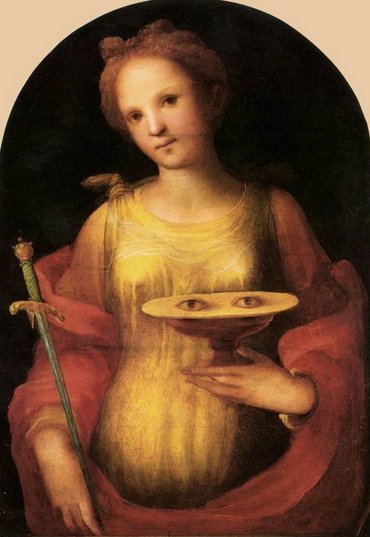
APRIL 11 (101
→ Sirius) - 6 = APRIL 5 (95
→ Canopus).
APRIL 11 (101 → Sirius)
- 12 ('years') = MARCH 31 at Haedus I (*73).
... His wish was to prove the oracle false, by
turning night into days and so living twelve years
in the space of six ...
 |
 |
|
Ba9-40 |
Ba9-41 (381) |
| ki te verega o to kava |
kua hati
hia mai ko to kava |
|
APRIL 15 |
16 (106) |
|
η
Leporis (89.0),
PRAJA-PĀTI (Lord of Created
Beings) =
δ
Aurigae,
MENKALINAN (Shoulder of the Rein-holder) =
β
Aurigae, MAHASHIM (Wrist) =
θ
Aurigae,
and
γ
Columbae (89.3),
π
Aurigae (89.4),
η
Columbae (89.7)
*48.0 = *89.4 - *41.4 |
μ
Orionis (90.3), χ² Orionis (90.5) |
| June 18 (169 =
172 - 3) |
19 |
 |
 |
 |
 |
 |
 |
 |
 |
|
Ba9-42 (382) |
Ba9-43 |
Ba9-44 |
Ba9-45 |
Ba9-46 |
Ba9-47 |
Ba9-48 |
Ba9-49 |
| e kua haga
hia i to topa |
koia ra kua hakavari |
ki te henua - kua
hua hia mai |
ki te henua ko te
henua kua noho |
ki te
ariki |
ko te ariki kua mau
ki tona tuura |
e manu itiiti era e |
|
Topa. 1.
To bend down, to drop to the ground; to fall on a certain date. 2.
To stop doing something, to drop; ina ekó topa taau aga, do
not stop, keep doing your work. 3. To remain, to be left over, to be
unfinished; he topa te kai, the food is not finished, there
is some left. 4. To come to one's memory; i te aamu he topa te
vânaga tûai, in the legends old words come to memory. 5. To
remember, to reflect (with mana'u as subject); e-topa
rivariva tokorua mana'u ki te me'e nei, let the two of you think
carefully about this thing. Vanaga. 1. Wine; topa tahaga, id.
2. To fall in drops, to descend, to go down, to abdicate; topa
iho, to fall; hakatopa, to knock down, to cause to fall;
hakatopa ki raro, to knock down, to subjugate. 3. Childbirth,
abortion; topa te poki, to lie in. 4. A feast, to feast. 5.
To arrive, to result; topa rae, newcome; topa iho, to
come unexpectedly; topa ke, to deviate; topa no mai,
topa hakanaa, topa tahaga, mau topa pu,
unexpected; topa okotahi, solitary; hakatotopa, to
excite, to foment. 6. Bad, low, cheap, failure; igoa topa,
nickname; ariga topa, sinister, sly, ill-tempered, to hang
the head; hakatopa, to disparage; hakatotopa,
irresolute. 7. (Of upward movement) topa ki raro, to scale,
to surpass; hakatopa ki te ao, to confer a dignity;
hakatopa ki te kahu, to spread a sail; hakatotopa, to
make a genealogy. Churchill. |
|
APRIL 17 |
18 (108) |
19 |
20 |
21 (111) |
22 |
23 |
24 |
|
6h (91.3)
ν
Orionis (91.4),
θ
Columbae (91.5),
π
Columbae (91.6)
*50.0 = *91.4 - *41.4 |
ξ
Orionis
(92.5) |
Al
Han'ah-4 (Brand) /
Maru-sha-pu-u-mash-mashu-7 (Front of the Mouth of the Twins)
TEJAT
PRIOR = η
Gemini
(93.4),
γ
Monocerotis (93.5),
κ
Aurigae (93.6),
κ
Columbae (93.8)
*52.0 = *93.4 - *41.4 |
FURUD = ζ Canis
Majoris
(94.9) |
Well-22 (Tapir) /
Arkū-sha-pu-u-mash-mashu-8 (Back of the Mouth of the Twins)
δ
Columbae (95.2),
TEJAT
POSTERIOR = μ
Gemini, MIRZAM (The Roarer) =
β
Canis Majoris (95.4),
CANOPUS (Canopy) =
α
Carinae
(95.6),
ε
Monocerotis (95.7),
ψ1
Aurigae (95.9)
*54.0 = *95.4 - *41.4 |
No
star listed (96) |
β
Monocerotis, ν Gemini (97.0) |
No
star listed (98) |
|
June 20 |
Solstice |
22 |
23 |
24 (175) |
25 |
26 |
27 |

|
























.jpg)















